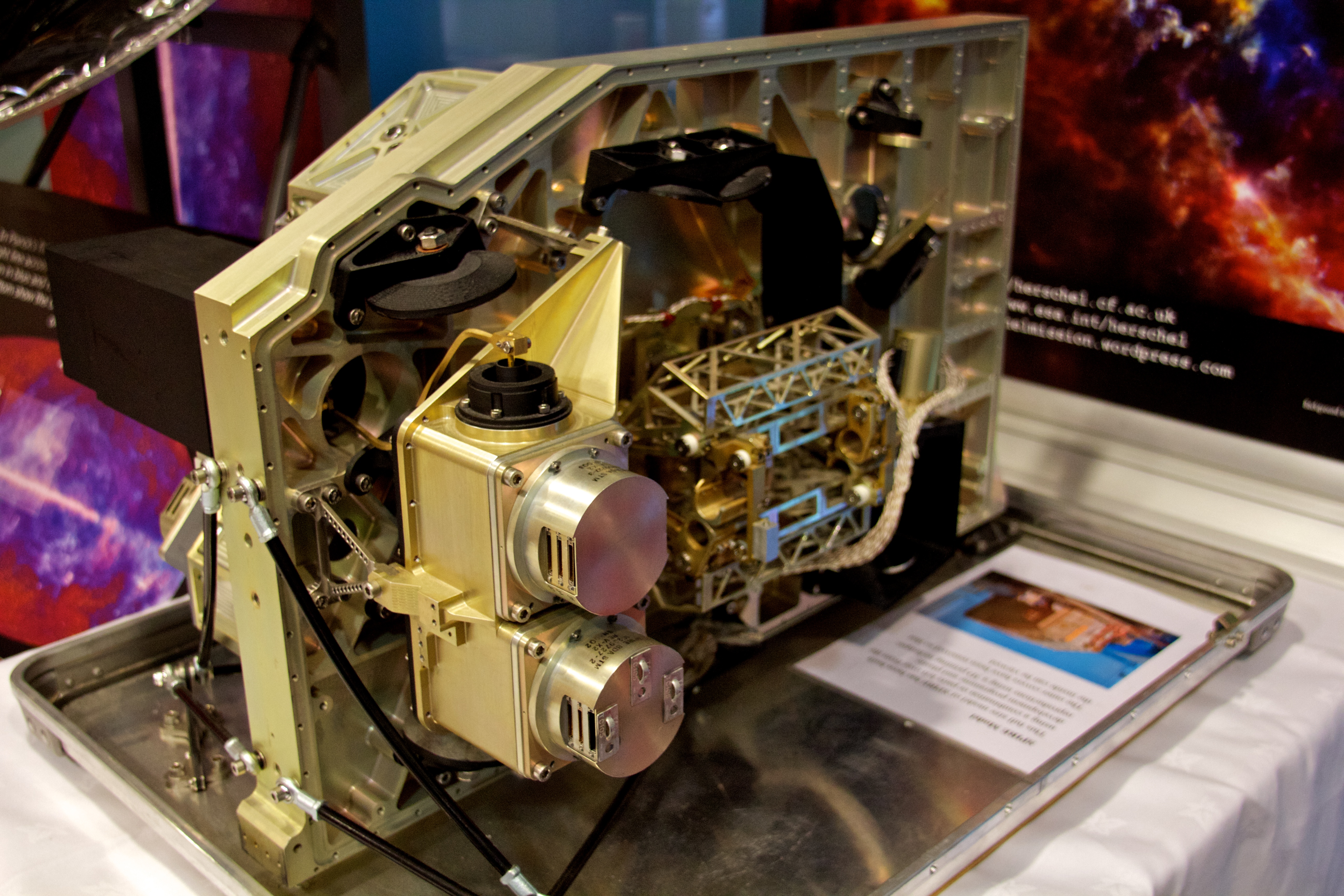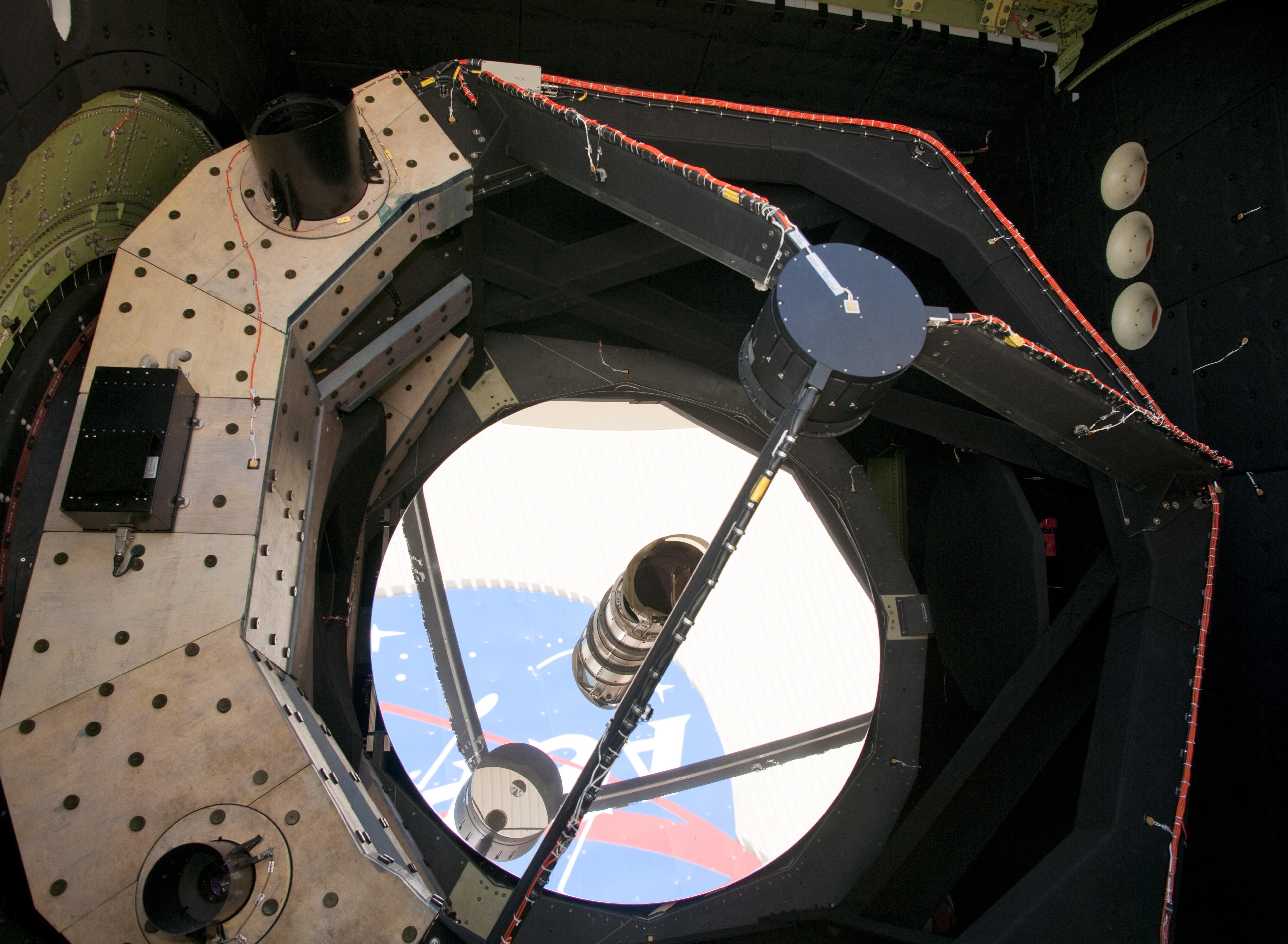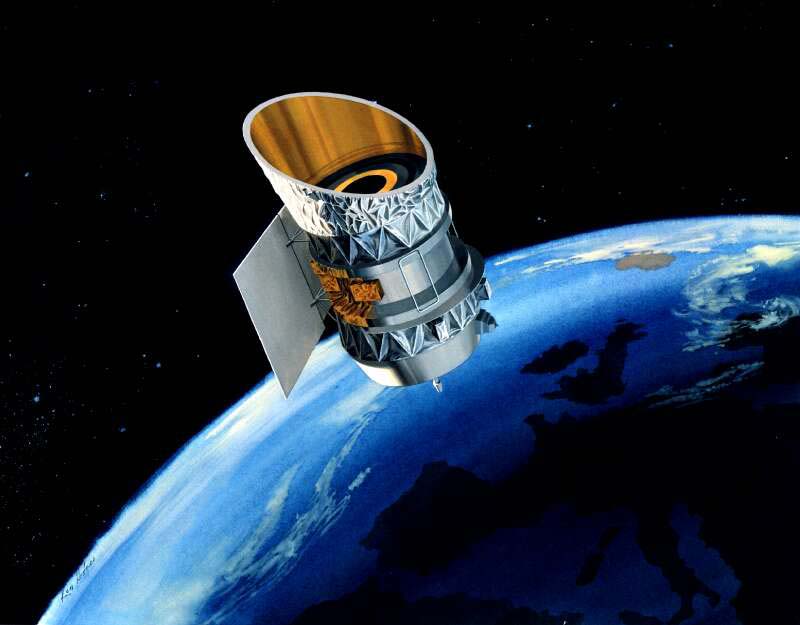|
Far-infrared Astronomy
Far-infrared astronomy is the branch of astronomy and astrophysics that deals with objects visible in far-infrared radiation (extending from 30 μm towards submillimeter wavelengths around 450 μm). In the far-infrared, stars are not especially bright, but emission from very cold matter (140 Kelvin or less) can be observed that is not seen at shorter wavelengths. This is due to thermal radiation of interstellar dust contained in molecular clouds. These emissions are from dust in circumstellar envelopes around numerous old red giant stars. The Bolocam Galactic Plane Survey mapped the galaxy for the first time in the far-infrared. Telescopes On 22 January 2014, European Space Agency scientists reported the detection, for the first definitive time, of water vapor on the dwarf planet, Ceres, largest object in the asteroid belt. The detection was made by using the far-infrared abilities of the Herschel Space Observatory. The finding is unexpected because comets, not astero ... [...More Info...] [...Related Items...] OR: [Wikipedia] [Google] [Baidu] |
Andromeda Galaxy - Herschel - Nhsc2013-004a
Andromeda most commonly refers to: * Andromeda (mythology), a princess from Greek mythology * Andromeda (constellation), a region of the Earth's night sky * The Andromeda Galaxy, an astronomical object within the constellation Andromeda may also refer to: Artistic works Fine art * ''Andromeda Chained to the Rocks'', a 1631 painting by Rembrandt * ''Andromeda (Rodin)'', an 1889 sculpture by Auguste Rodin Literature * Andromeda (play), ''Andromeda'' (play), lost mythological tragedy by Euripides from 412 BC * Andromeda (novel), ''Andromeda'' (novel), 1957 science fiction novel by Ivan Yefremov * The Andromeda Strain, ''The Andromeda'' Strain, 1969 techno-thriller novel by Michael Crichton * The Andromeda Evolution, 2019 science fiction novel by Daniel H. Wilson, sequel to The Andromeda Strain Music * Andromeda (English band), a 1960s psychedelic rock band from Britain, or their eponymous debut album * Andromeda (Swedish band), a 2000s progressive metal band from Sweden * ... [...More Info...] [...Related Items...] OR: [Wikipedia] [Google] [Baidu] |
Herschel Space Observatory
The Herschel Space Observatory was a space observatory built and operated by the European Space Agency (ESA). It was active from 2009 to 2013, and was the largest infrared telescope ever launched until the launch of the James Webb Space Telescope in 2021. Herschel carries a mirror and instruments sensitive to the far infrared and submillimetre wavebands (55–672 µm). Herschel was the fourth and final cornerstone mission in the Horizon 2000 programme, following ''SOHO''/'' Cluster II'', '' XMM-Newton'' and ''Rosetta''. The observatory was carried into orbit by an Ariane 5 in May 2009, reaching the second Lagrangian point (L2) of the Earth–Sun system, from Earth, about two months later. Herschel is named after Sir William Herschel, the discoverer of the infrared spectrum and planet Uranus, and his sister and collaborator Caroline Herschel. The observatory was capable of seeing the coldest and dustiest objects in space; for example, cool cocoons where stars for ... [...More Info...] [...Related Items...] OR: [Wikipedia] [Google] [Baidu] |
Infrared Astronomy
Infrared astronomy is a sub-discipline of astronomy which specializes in the observation and analysis of astronomical objects using infrared (IR) radiation. The wavelength of infrared light ranges from 0.75 to 300 micrometers, and falls in between visible radiation, which ranges from 380 to 750 nanometers, and submillimeter waves. Infrared astronomy began in the 1830s, a few decades after the discovery of infrared light by William Herschel in 1800. Early progress was limited, and it was not until the early 20th century that conclusive detections of astronomical objects other than the Sun and Moon were made in infrared light. After a number of discoveries were made in the 1950s and 1960s in radio astronomy, astronomers realized the information available outside the visible wavelength range, and modern infrared astronomy was established. Infrared and optical astronomy are often practiced using the same telescopes, as the same mirrors or lenses are usually effective over a wav ... [...More Info...] [...Related Items...] OR: [Wikipedia] [Google] [Baidu] |
Submillimeter Array
The Submillimeter Array (SMA) consists of eight diameter radio telescopes arranged as an interferometer for submillimeter wavelength observations. It is the first purpose-built submillimeter interferometer, constructed after successful interferometry experiments using the pre-existing James Clerk Maxwell Telescope and Caltech Submillimeter Observatory (now decommissioned) as an interferometer. All three of these observatories are located at Mauna Kea Observatory on Mauna Kea, Hawaii, and have been operated together as a ten element interferometer in the 230 and 345 GHz bands (eSMA, for extended Submillimeter Array). The baseline lengths presently in use range from . The radio frequencies accessible to this telescope range from which includes rotational transitions of dozens of molecular species as well as continuum emission from interstellar dust grains. Although the array is capable of operating both day and night, most of the observations take place at nighttime wh ... [...More Info...] [...Related Items...] OR: [Wikipedia] [Google] [Baidu] |
High Elevation Antarctic Terahertz Telescope
The High Elevation Antarctic Terahertz telescope is a far-infrared telescope, established by the University of Arizona and the University of New South Wales located at Ridge A at an altitude of , considered the most ideal location for observation in the world. The extraordinary low humidity makes Inner Antarctica the best (by far) region for submillimeter astronomy observations. The telescope is robotic, remote controlled. It is mostly operated during the local winter, when the average temperature is . See also * List of astronomical observatories *List of radio telescopes This is a list of radio telescopes – over one hundred – that are or have been used for radio astronomy. The list includes both single dishes and interferometric arrays. The list is sorted by region, then by name; unnamed telescopes are in r ... References Astronomical telescopes and observatories in the Antarctic Infrared telescopes 2012 establishments in Antarctica {{observatory-stub ... [...More Info...] [...Related Items...] OR: [Wikipedia] [Google] [Baidu] |
Caltech Submillimeter Observatory
The Caltech Submillimeter Observatory (CSO) was a 10.4-meter (34 ft) diameter submillimeter wavelength telescope situated alongside the 15-meter (49 ft) James Clerk Maxwell Telescope (JCMT) at Mauna Kea Observatories. It was engaged in submillimeter astronomy, of the terahertz radiation band. The telescope closed on September 18, 2015. As of April 2019, the telescope is set to be dismantled and its site remediated in the near future as part of the Mauna Kea Comprehensive Management Plan. History In 1973 Robert Leighton proposed to the NSF to build four 10.4 meter diameter parabolic dish radio antennas. Three of these Leighton antennas were to be used as a mm-wave interferometer to be sited at OVRO, and the fourth was to be used as a single submillimeter telescope at a high mountain site. The proposal was approved (AST 73-04908), but the NSF insisted that the mm-wave array had to be completed before work on the submillimeter telescope could be started, which delaye ... [...More Info...] [...Related Items...] OR: [Wikipedia] [Google] [Baidu] |
James Clerk Maxwell Telescope
The James Clerk Maxwell Telescope (JCMT) is a submillimetre-wavelength radio telescope at Mauna Kea Observatory in Hawaii, US. The telescope is near the summit of Mauna Kea at . Its primary mirror is 15 metres (16.4 yards) across: it is the largest single-dish telescope that operates in submillimetre wavelengths of the electromagnetic spectrum ( far-infrared to microwave).W.S. Holland et al., SCUBA: a common-user submillimetre camera operating on the James Clerk Maxwell Telescope, Monthly Notices of the Royal Astronomical Society: Letters Volume 303 Issue 4, Pages 659–672, 2002 Scientists use it to study the Solar System, interstellar dust and gas, and distant galaxies. The JCMT started operations in 1987, and was funded until February 2015 by a partnership between the United Kingdom and Canada, and the Netherlands. It was operated by the Joint Astronomy Centre and was named in honour of mathematical physicist James Clerk Maxwell. In March 2015 the operation of the JCMT w ... [...More Info...] [...Related Items...] OR: [Wikipedia] [Google] [Baidu] |
Stratospheric Observatory For Infrared Astronomy
The Stratospheric Observatory for Infrared Astronomy (SOFIA) was an 80/20 joint project of NASA and the German Aerospace Center (DLR) to construct and maintain an airborne observatory. NASA awarded the contract for the development of the aircraft, operation of the observatory and management of the American part of the project to the Universities Space Research Association (USRA) in 1996. The DSI (Deutsches SOFIA Institut) managed the German parts of the project which were primarily science- and telescope-related. SOFIA's telescope saw first light on May 26, 2010. SOFIA was the successor to the Kuiper Airborne Observatory. During 10-hour, overnight flights, it observed celestial magnetic fields, star-forming regions, comets, nebulae, and the Galactic Center. Science flights have now concluded, after the landing of the 921st and last flight in the early morning of September 29, 2022. The project will continue to work with legacy data for a few years. [...More Info...] [...Related Items...] OR: [Wikipedia] [Google] [Baidu] |
Infrared Space Observatory
The Infrared Space Observatory (ISO) was a space telescope for infrared light designed and operated by the European Space Agency (ESA), in cooperation with ISAS (now part of JAXA) and NASA. The ISO was designed to study infrared light at wavelengths of 2.5 to 240 micrometres and operated from 1995 to 1998. The €480.1-million satellite was launched on 17 November 1995 from the ELA-2 launch pad at the Guiana Space Centre near Kourou in French Guiana. The launch vehicle, an Ariane 44P rocket, placed ISO successfully into a highly elliptical geocentric orbit, completing one revolution around the Earth every 24 hours. The primary mirror of its Ritchey-Chrétien telescope measured 60 cm in diameter and was cooled to 1.7 kelvins by means of superfluid helium. The ISO satellite contained four instruments that allowed for imaging and photometry from 2.5 to 240 micrometres and spectroscopy from 2.5 to 196.8 micrometers. ESA and the Infrared Processing and Analysis Center made effor ... [...More Info...] [...Related Items...] OR: [Wikipedia] [Google] [Baidu] |
IRAS
The Infrared Astronomical Satellite (Dutch: ''Infrarood Astronomische Satelliet'') (IRAS) was the first space telescope to perform a survey of the entire night sky at infrared wavelengths. Launched on 25 January 1983, its mission lasted ten months. The telescope was a joint project of the United States (NASA), the Netherlands ( NIVR), and the United Kingdom ( SERC). Over 250,000 infrared sources were observed at 12, 25, 60, and 100 micrometer wavelengths. Support for the processing and analysis of data from IRAS was contributed from the Infrared Processing and Analysis Center at the California Institute of Technology. Currently, the Infrared Science Archive at IPAC holds the IRAS archive. The success of IRAS led to interest in the 1985 Infrared Telescope (IRT) mission on the Space Shuttle, and the planned Shuttle Infrared Telescope Facility which eventually transformed into the Space Infrared Telescope Facility, SIRTF, which in turn was developed into the Spitzer Space ... [...More Info...] [...Related Items...] OR: [Wikipedia] [Google] [Baidu] |
Spitzer Space Telescope
The Spitzer Space Telescope, formerly the Space Infrared Telescope Facility (SIRTF), was an infrared space telescope launched in 2003. Operations ended on 30 January 2020. Spitzer was the third space telescope dedicated to infrared astronomy, following IRAS (1983) and ISO (1995–1998). It was the first spacecraft to use an Earth-trailing orbit, later used by the Kepler planet-finder. The planned mission period was to be 2.5 years with a pre-launch expectation that the mission could extend to five or slightly more years until the onboard liquid helium supply was exhausted. This occurred on 15 May 2009. Without liquid helium to cool the telescope to the very low temperatures needed to operate, most of the instruments were no longer usable. However, the two shortest-wavelength modules of the IRAC camera continued to operate with the same sensitivity as before the helium was exhausted, and continued to be used into early 2020 in the Spitzer Warm Mission. During the warm missi ... [...More Info...] [...Related Items...] OR: [Wikipedia] [Google] [Baidu] |
Herschel In Space Close Up On Its Mirror Node Full Image
Herschel or Herschell may refer to: People * Herschel (name), various people Places * Herschel, Eastern Cape, South Africa * Herschel, Saskatchewan * Herschel, Yukon * Herschel Bay, Canada * Herschel Heights, Alexander Island, Antarctica * Herschel Island, Canada * Mount Herschel, Antarctica * Cape Sterneck, Antarctica Astronomy * Herschel (crater), various craters in the solar system * 2000 Herschel, an asteroid * 35P/Herschel–Rigollet, a comet * Herschel Catalogue (other), various astronomical catalogues of nebulae * Herschel Medal, awarded by the UK Royal Astronomical Society * Herschel Museum of Astronomy, in Bath, United Kingdom * Herschel Space Observatory, operated by the European Space Agency * Herschel wedge, an optical prism used in solar observation * Herschel's Garnet Star, a red supergiant star * William Herschel Telescope, in the Canary Islands * Telescopium Herschelii, a constellation * Uranus, for a time known as Herschel Other uses * ... [...More Info...] [...Related Items...] OR: [Wikipedia] [Google] [Baidu] |





.jpg)



